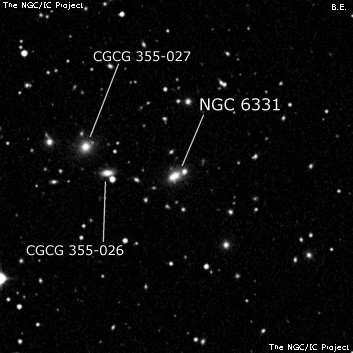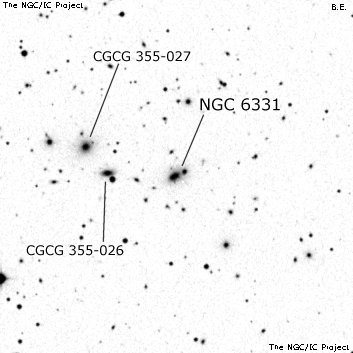NGC/IC Project Restoration Effort
(This is a very very beta version)
NGC6331


Basic Information
Location and Magnitude
Right Ascension: 17:3:34.3
Declination: +78:37:47
Constellation: UMI
Visual Magnitude: 14.4
Historic Information
Discoverer: Herschel W.
Year of discovery: 1797
Discovery aperture: 18.7
Observational
Summary description: eF, S
Sub-type: E3
Corwin's Notes
=====
NGC 6331. There is a single observation by WH who says "eF, S. 320 shewed
[sic] it better." CH lists two offsets in her fair copy of the sweep, the
main one being the one that WH published in his Third Catalogue: 21min 18sec
preceding and 1deg 25arcmin south of "4 Cephei of Bode's Cat." which is
HD 158996. This star has a high proper motion (+56.6 mas/yr in RA and +207.1
mas/yr); this may have influenced its corrections to WH's observations in the
sweep. They are a minute of time and 3 arcminutes off those for the other two
stars in the same sweep, so it is not a particularly good reference star.
The other star that CH lists is "2 Cephei of Bode's Cat."; this is HD 152303.
It is written in an otherwise small space in the sweep in a bit of a cramped
hand; I suspect it was added later when CH noticed that "4 Cephei" gave a
different correction than the other two stars. In any event, the offsets she
gives for the observation are 22 min 55 sec following and 59 arcminutes north
of the star. I've reduced WH's observation with respect to both stars, and as
you'll see in the position table, his position using HD 152303 is considerably
closer to the position provided by Bigourdan, and to the modern positions.
There are a couple of unusual aspects of the object that might affect its
identification, though the corrected position (and Bigourdan's observation)
pretty well pin it down as the brightest object in the cluster Abell 2256.
First, the object is a triple system. This might have reduced its visibility
a bit, but the blended image seems to have been the only one in the cluster
that WH and Bigourdan saw. This is a bit curious as the 2nd and 3rd brightest
galaxies are only 0.1 and 0.2 magnitudes fainter, and are just 2 arcminutes to
the east. NGC 6331 must have been right at the limit of visibility for both
of the keen-eyed observers to miss the companions. In any event, neither of
them saw any other galaxies in the cluster.
Steve's Notes
=====
NGC 6331
24" (8/7/13): brightest member of Abell Galaxy Cluster 2256 and first in a 6' string to the east containing a total of 6 galaxies. At 375x appeared fairly faint, fairly small, oval 5:3 NW-SE, ~30"x18", broad concentration, brighter core. This is a very close double system (two nuclei on the SDSS) with a companion on the NW side. A mag 13 star lies 1.8' E and this star is attached on the southwest side of CGCG 355-026. PGC 84834, an extremely faint and small galaxy lies 1.1' E, on line with the mag 13 star. Also in the string is UGC 10726 2.7' ENE, MCG +13-12-019 3.7' ENE, PGC 59471 4.4' SW and MCG +13-12-020 6' E. In addition, PGC 59495 lies 2.4' SW.
UGC 10726: faint to fairly faint, irregularly round, ~35" diameter, broad weak concentration. This galaxy and NGC 6331 are the two largest in the cluster.
MCG +13-12-019: faint, fairly small, round, 18" diameter.
PGC 59471: extremely faint and small, only 6" diameter.
MCG +13-12-020: very faint, small, round, 18" diameter, low even surface brightness. A mag 11.3 star is 1.4' E.
PGC 59495: very faint, extremely small, round, 10" diameter.
18" (7/5/08): at 280x, appeared fairly faint, fairly small, elongated 2:1 WNW-ESE (a very faint companion at the WNW end may contribute to the impression of elongation), 40"x20", even surface brightness. Brightest in the core of distant AGC 2256 (~800 million light years) with 6 faint companions picked up within 6'. NGC 6331 is the first in a 3.7' curving chain of 5 galaxies extending to the east. A mag 13.9 star lies within this chain 1.7' E.
17.5" (5/14/88): faint, small, elongated NW-SE. A mag 13.5 star is 1.8' E. UGC 10726 lies 2.7' E. This is the brightest galaxy in AGC 2256 galaxy cluster and a triple system in a common halo.



